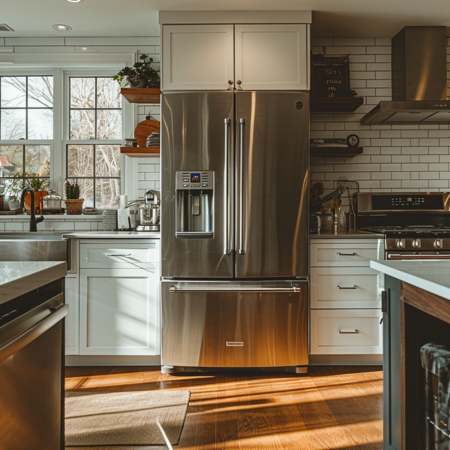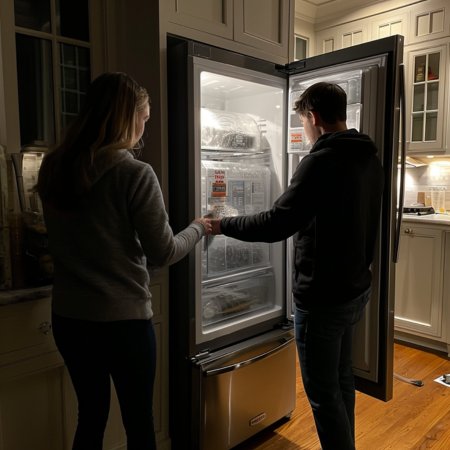Built-in refrigerators, known for their sleek and seamless integration into kitchen cabinetry, are a staple in many modern homes.
However, there may come a time when you consider replacing them, possibly due to functionality, cost-efficiency, or style preferences.
A common question in this context is whether it’s feasible to substitute a built-in refrigerator with a regular, freestanding one.
This article deeply explores this question, addressing the key considerations and practical implications of such a replacement.
Whether planning a kitchen revamp or simply curious, this article provides valuable insights to guide your decision-making process.
Key Points
- Dimension Compatibility: Ensuring fit between regular fridge and built-in space.
- Installation Ease: Freestanding units typically require less complicated installation.
- Budget Considerations: Regular refrigerators are generally less expensive than built-ins.
- Aesthetic Impact: Freestanding fridges may disrupt the kitchen’s integrated, seamless look.
Can You Replace A Built-in Refrigerator With A Regular One
Yes, you can replace a built-in refrigerator with a regular one. But, it’s not always a straightforward swap. There are several factors to consider.
The first consideration is the size. Built-in refrigerators typically have specific dimensions. They’re designed to fit snugly into the cabinetry. A freestanding refrigerator might not fit perfectly in the same space.
Secondly, there’s the matter of aesthetics. Built-in refrigerators offer a seamless look. They blend into the kitchen decor.
A freestanding refrigerator may disrupt this harmony. It may stand out and not gel with your kitchen design.
Next is the issue of ventilation. Built-in fridges have a different ventilation system. They expel heat from the front.
Regular refrigerators, on the other hand, release heat from the back. This difference could have implications for placement and cabinetry design.
Lastly, cost is a significant factor. Freestanding refrigerators are often less expensive. They may offer a cost-effective alternative if budget is a concern.
However, potential redesign and installation costs need consideration.
In conclusion, while replacing a built-in refrigerator with a regular one is possible, the process requires thoughtful planning.
These factors will guide you to make the best decision for your situation.
Benefits Of A Regular Refrigerator Over A Built-in One
Freestanding or regular refrigerators, while different in design and installation, offer several unique advantages over built-in models.
Below are four reasons why choosing a regular refrigerator might be more beneficial for you:
1. Flexibility in Placement
Regular refrigerators offer the benefit of flexible placement. They aren’t locked into one position like their built-in counterparts. You can move them around based on your needs and convenience.
Their freestanding design enables variation in positioning. For instance, you might want to shift it closer to your dining area or away from high-traffic kitchen zones. This ability to reposition it as needed can enhance the functionality of your kitchen space.
2. Ease of Installation
Installation of a regular refrigerator is usually straightforward. Unlike built-in models, it doesn’t require much planning or custom fitting. You buy the refrigerator, place it where you want, and plug it in.
This ease of installation can save you time and potential installation costs. It’s a significant advantage if you want a hassle-free setup process.
3. Variety in Models
Another notable edge regular refrigerators have is the wide variety of models available. They come in different shapes, sizes, and designs. Plus, they offer a wide range of features.

From door designs to storage options, the choices are numerous. This variety allows you to choose a model that suits your needs and preferences perfectly.
4. Greater Capacity for Storage
Regular refrigerators often boast a greater storage capacity. Built-in models, while sleek, may not provide as much space.
Having a spacious fridge is a big plus. It allows you to store more food items.
Having a variety of fresh produce on hand is easier. You can also store meal preps or leftovers without worry. Bulky items like turkey or a large birthday cake? No problem!
This extra room can make a big difference.
Especially in a household with many family members.
Greater storage capacity means more convenience for you. Consider this when choosing your next fridge.
5. Easier and Cheaper to Repair or Replace
Regular refrigerators have an edge in the repair or replacement aspect, too.
These models are easier to fix. Parts are readily available.
Technicians are familiar with the common issues. Thus, repairs are speedy and less costly.
Also, if a replacement is required, it’s a straightforward process. Choose a new model. Unplug the old one.
Replace it with the new one. Simple as that. These advantages make regular refrigerators a practical choice. When buying, remember to consider these points.
They can save you time, and money, and avoid unnecessary stress.
Replacing A Built-in Refrigerator With A Regular One?
Swapping a built-in refrigerator with a regular one is a task that requires careful planning and execution. This process involves a few essential steps which are outlined below.
1. Measure the Space
First, measure the available space.
It would help if you had the height, width, and depth. Be precise. Accuracy is key.
Next, consider the doors. The fridge door needs room to open.
Check the swing direction. Can it be changed if needed? Don’t forget the power outlet.
Is it in a convenient location? Lastly, think about ventilation.
Does the space allow for adequate airflow?
Remember these points. They ensure a smooth transition from a built-in fridge to a regular one.
2. Purchase the New Refrigerator
Choose your new refrigerator wisely. Consider size, features, and energy efficiency. Shop around. Compare different models.
Read reviews. Check the manufacturer’s reputation. Remember, energy-efficient models save on utility bills.
Buy from a reputable dealer. Check their delivery and installation service. Do they remove the old fridge? Inquire about warranties and after-sales service.
Ensure you have the correct measurements when buying. This way, your new fridge fits perfectly in the space.
Making a good purchase decision can save you from future headaches. It guarantees the longevity and efficient performance of your new refrigerator.
3. Disconnect the Built-in Refrigerator
Before disconnecting the old fridge, unplug it. Safety comes first.
Empty it. Remove all food and drinks.
Defrost the freezer. Avoid flooding when it’s moved.
Dispose of the water properly.

Next, disconnect the water line. Do this if your fridge has a water dispenser or ice maker. You might need a wrench for this.
Finally, unscrew the fridge from the wall. Built-in fridges are usually screwed in.
Be careful not to damage the wall or floor. Now, your fridge is ready to be moved.
4. Remove the Built-in Refrigerator
Firstly, gather the necessary tools. You’ll likely need a dolly and straps.
Check the pathway. Make sure it’s clear.
Get assistance. Moving heavy appliances isn’t a one-person job.
Start moving. Be gentle. Avoid causing damage.
Go slow. Safety is crucial.
Navigate carefully. Watch out for corners and doors.
Once outside, load it onto a vehicle. If it’s still working, consider donating it.
Congratulations! You’ve successfully removed your built-in refrigerator. Now, you’re ready for the new one.
5. Install the New Refrigerator
Begin with unboxing. Remove all packaging materials.
Next, move the fridge close to its space. Be careful, and avoid damaging the appliance.
Check the water line. Make sure it’s connected. This is essential for dispensers and ice makers.
Now, plug in the fridge. Ensure the socket is not overloaded.
Slide the fridge into place. Use gentle movements.
Secure it to the wall. Use screws if necessary.
Open the doors. Check they swing freely.
Finally, adjust the temperature settings. Allow it to cool before adding food.
Congratulations! Your new refrigerator has been installed successfully.
6. Check the New Refrigerator’s Functioning
Start by checking the lights. They should come on when doors are opened.
Listen for the motor. It should run smoothly.
Next, check the temperature. After 24 hours, it should be cold.
Test the water dispenser. It should work if connected properly.
Check the ice maker. It should make ice after a few hours.
Lastly, inspect the door seals. They should close tightly.
Over time, check energy consumption. It should align with the manufacturer’s specifications.
Remember, regular maintenance extends the appliance’s lifespan. Enjoy your new refrigerator!
7. Dispose of or Recycle the Old Refrigerator
Disposing of an old refrigerator requires careful thought.
First, check local regulations. Different areas have different rules.
Second, consider recycling. Some parts can be reused.
Third, hire a professional. They know proper disposal methods.
Fourth, think about donating. If it’s still functional, someone may find it valuable.
Fifth, sell it for scrap. Metal parts could be sold.
In conclusion, don’t just dump your old refrigerator. Dispose of it responsibly. Remember, we’re all stewards of our environment.
Conclusion
Installing and properly disposing of a refrigerator may seem daunting, but it’s a breeze with proper guidance.
By following these steps, not only have you successfully set up your new appliance, but you’ve also responsibly handled your old one.
This mindful consumption and disposal process is crucial in our collective responsibility towards environmental conservation.
Whether it’s a refrigerator or any other appliance, let’s strive to make eco-friendly choices and promote sustainability.
- Can You Put Microwave Popcorn In The Oven: Pros And Cons - May 14, 2024
- Can You Scrap A Microwave And Why You Should? - May 13, 2024
- Can You Put Metal In A Convection Microwave: 10 Major Risks - May 12, 2024

